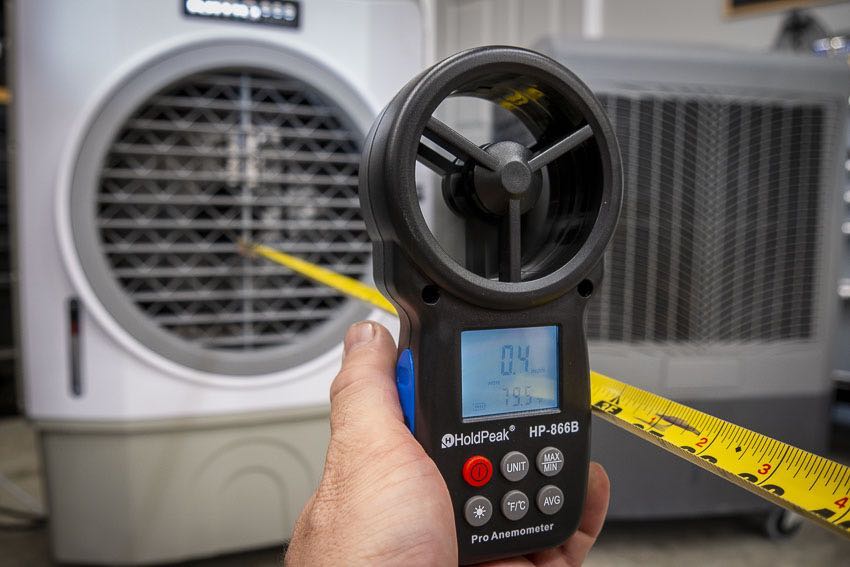Buying an evaporative cooler is one way to beat the heat, especially if you live in less humid climates (we’re looking at you, Arizona!). There are a lot of swamp cooler options out there, and some make some impressive claims.
With some attractively-priced models available, we wanted to know just how well the claims stack up against reality. So we brought in several models to take a closer look and see what you’re getting for your hard-earned money.
Evaporative Cooler vs Swamp Cooler
What’s the difference between an evaporative cooler and a swamp cooler? In short, nothing. They’re just two different names for the same appliance.
How Does an Evaporative Cooler Work?
An evaporative cooler, or swamp cooler, works by pulling in dry air, adding moisture to it, and blowing out more humid air than it started with.
A fan blade takes care of the airflow, just like a normal fan. It pulls air in through the back and sides, then accelerates it out through the front.
There’s a reservoir at the bottom of the swamp cooler that holds water. A pump pulls it to the top and distributes it over filter-like pads that cover the back and sides. As the fan pulls air through them, it’s able to pick up additional moisture. Rather than coming out as a mist, it raises the humidity level.
That may sound like you’re simply taking Arizona’s heat and adding Florida’s humidity, but it’s actually much more comfortable than that. The fan keeps air moving over you and the extra moisture promotes evaporative cooling over your skin that’s more effective than airflow alone.
It’s worth noting that evaporative coolers do their best work when the relative humidity is below 60%.
Buying a Swamp Cooler
We brought in four different evaporative coolers to look at what they claim compared to what they deliver. At the same time, we’ll help you understand the things we look for in a swamp cooler so you can decide for yourself which model is best for you.
Note: You may notice an ammonia smell when you first open your evaporative cooler. It’s because of what they treat the filters with and is normal. Go ahead and set it up outside and run a tank of water through it overnight. The smell will go away on its own—usually after a few hours.
Swamp Coolers: What We Look For
- CFM (cubic feet per minute): This is a measure of airflow. The higher the value, the more air that’s moving across you and the better the cooling effect. We’ve measured some numbers that vary greatly from manufacturer’s claims.
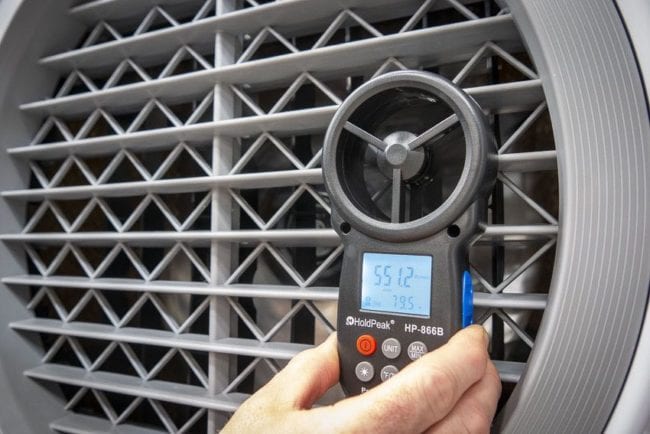
- Airspeed: We check airspeed at several intervals to see how well the cooling effect transfers as you move away from the cooler. Models that reach out farther effectively cool large spaces better.
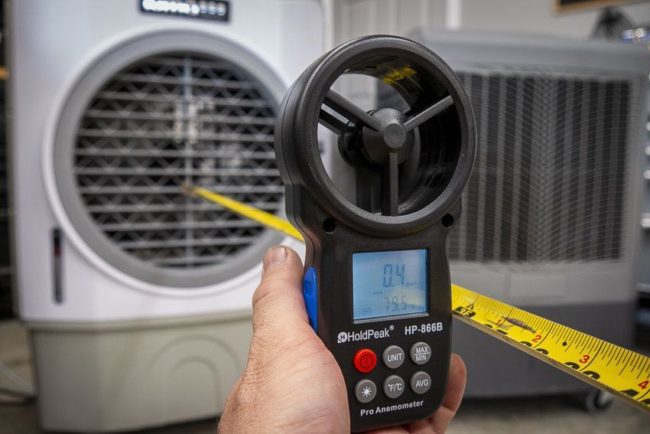
- Noise Level: You need to be in relatively close proximity to your swamp cooler. The less noise it produces, the less you have to compete with it to hear and be heard.
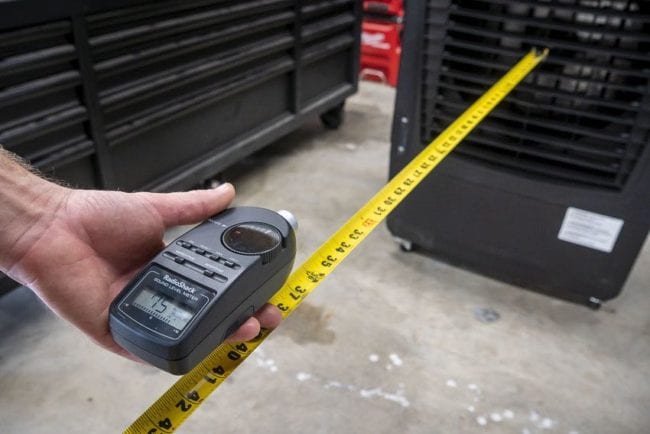
- Current Draw: Evaporative coolers don’t draw a ton of energy, but if you’re running on solar or a generator, the more energy-efficient, the better.
- GFCI (ground-fault circuit interrupter): These devices protect you from electrical shocks due to faults. Per the UL 507 standard, products marketed and intended for outdoor use must have GFCI plugs to meet this standard.
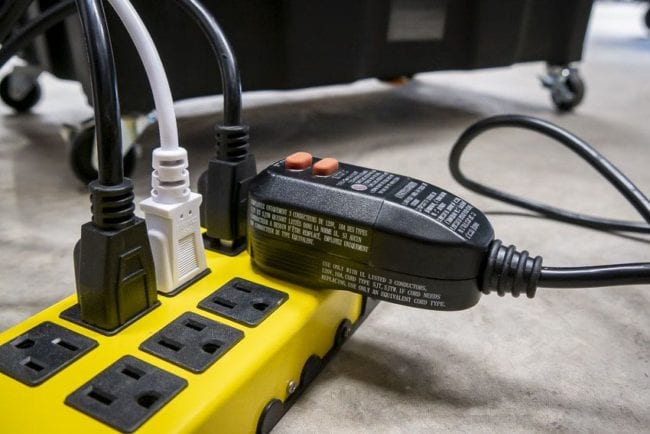
- Tank Size: Even though excess water recycles back to the tank, some water is constantly pulling into the air. The larger the tank, the less often you have to refill.
- Filter Size: More filter pad surface area means more air contact with the water and better humidity conversion.
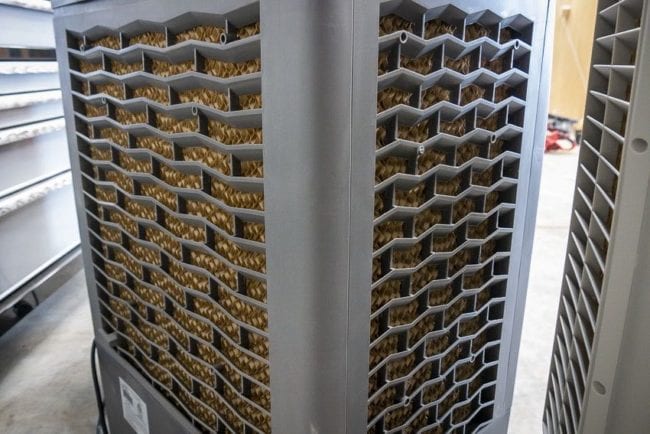
- Fan Blade Material: Metal and plastic blades can generate similar airflow, but plastic blades will deform over time when placed in rougher outdoor environments. Any changes in the blade could eventually affect airflow and fan noise.
- Price: Hey, everyone has to stay on a budget these days, right? Cheaper isn’t always better, though. Consider the quality and performance of the product against the price to gauge the cooler’s value.
Evaporative Cooler Testing Results
The evaporative coolers we brought in ranged from 1300 to 3100 CFM and cover 500 to 950 square feet, according to the manufacturers. What we found, however, is that not all swamp coolers are created equal.
Hessaire MC37M Swamp Cooler
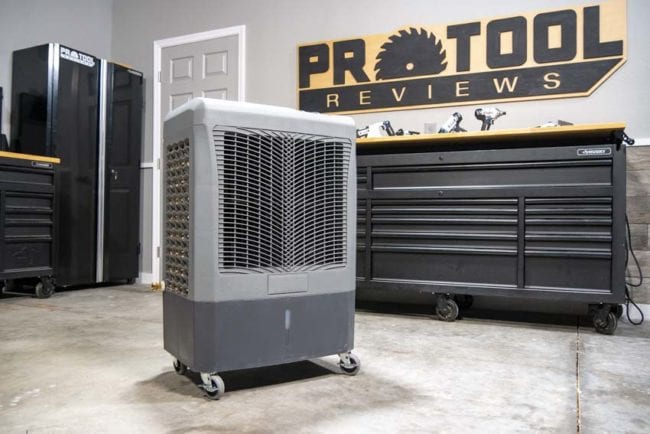
CFM
The Hessaire MC37M claims to get 3100 CFM, by far the largest of our sample group. We measured its discharge area at 220.24 square inches (1.53 square feet). With an average airspeed of 1352 feet per minute (15.36 MPH), we calculated the actual airflow at 2067 CFM on high. That’s a solid value, but missing the claimed mark by more than 1000 CFM or 34% is concerning.
Airspeed Change
Standing right at the discharge, the Hessaire MC37M pushes an average of 1352 fpm. Here’s how it changes over distance:
- 0 feet: 1352 fpm (15.63 MPH)
- 3 feet: 1100 fpm (12.5 MPH)
- 6 feet: 942 fpm (10.7 MPH)
- 12 feet: 625 fpm (7.1 MPH)
Maintaining this kind of air velocity keeps a fairly large area cool. In fact, it has the longest effective range of the units we tested.
Noise Level at 3 Feet (A-weighted, slow response)
- Low: 74 decibels
- Medium: 83 decibels
- High: 87 decibels
Not surprisingly, the strongest blowing swamp cooler we tested is also the loudest. You might have some trouble hearing the conversation if you’re sitting close to it. However, this model has a solid range on it and you can move further away and still feel the airflow.
Current Draw
We connected a clamp meter to a special extension cord we use to measure current draw. We measured the following results:
- Low: 0.9 amps
- Medium: 1.2 amps
- High: 1.7 amps
The Hessaire MC37M requires more current draw than other models we tested. If you’re on a generator or solar power, you might want to take a look at other options for better energy efficiency.
GFCI
Hessaire does not include a GFCI plug on this unit, but they also don’t specifically call out this unit for outdoor use—at least not in their user manual or on their website. If you use this device outdoors, we strongly recommend you use a GFCI extension cord or plug it into a GFCI outlet to reduce the risk of shock even though they actually recommend the opposite in their manual.
Tank Size
Hessaire’s 10.3-gallon tank size is smaller than others in a similar class, meaning you’ll need to refill it more often.
Filter Size
This Hessaire swamp cooler has 818 square inches of filter space, covering a reasonable area, though there are competitors with a better ratio of filter area to airflow.
Additional Notes
- 3 plastic blades used for the fan
- Tank fills at the base or with a garden hose connection
- Seams along the plastic are sharper and rougher than other models
- There’s a quality set of casters on this unit, rolling and turning easier than the other units we’ve tested
- No vertically adjustable louvers, but automatic lateral oscillation is included
More Numbers to Know
- Model: Hessaire MC37M
- Manufacturer Recommended Coverage Area: 950 square feet
- Weight: 40 pounds
- Dimensions (H/W/D): 37.25 x 24.13 x 16.25 inches
- Price: $299
Honeywell CO610PM Evaporative Cooler
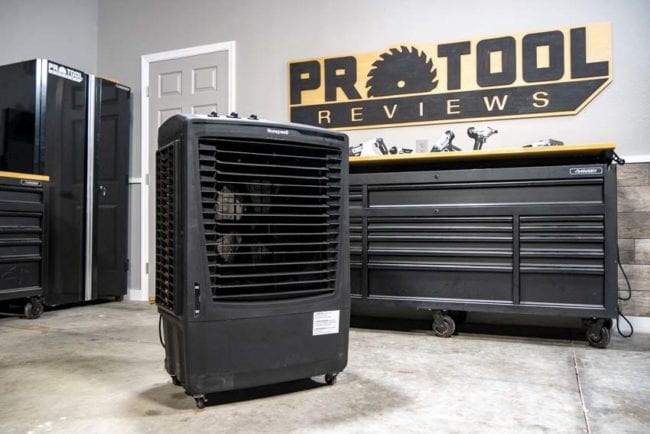
CFM
The Honeywell CO610PM boasts 2100 CFM. We measured its discharge area at 233.59 square inches (1.62 square feet). Its airspeed averaged 1294 feet per minute (14.70 MPH) and we calculated the actual airflow at 2099 CFM on high. It’s an excellent amount of airflow and easily the closest to its claimed value.
Airspeed Change
From the discharge, the Honeywell averages of 1294 fpm. Here’s how it changes over distance:
- 0 feet: 1294 fpm (14.70 MPH)
- 3 feet: 1082 fpm (12.3 MPH)
- 6 feet: 862 fpm (9.8 MPH)
- 12 feet: 563 fpm (6.4 MPH)
In terms of coverage area, this is another winner for larger spaces. Its effective distance is very close to the Hessaire MC37M.
Noise Level at 3 Feet (A-weighted, slow response)
- Low: 80 decibels
- Medium: 83 decibels
- High: 85 decibels
Honeywell comes in a bit quieter on high than Hessaire on the top end, louder on the low end, and matches its medium speed noise.
Current Draw
- Low: 0.9 amps
- Medium: 1.0 amps
- High: 1.1 amps
If you’re looking for an excellent balance between airflow and energy efficiency, the Honeywell CO610PM nails it. It uses 35% less power on high and has a little more tested airflow than the Hessaire unit.
GFCI
Honeywell includes a GFCI plug on this unit. In our test group, it’s the only model to have one. It’s also the only model to actually recommend and specify outdoor usage in its materials and product description.
Tank Size
Honeywell’s 14-gallon tank size is generous, giving you more time between refills than similar size units.
Filter Size
This large Honeywell evaporative cooler has 929 square inches of filter space – nearly 15% more than Hessaire’s. This should lead to better humidity conversion and more efficient evaporative cooling effects.
Additional Notes
- 5 metal blades used for the fan
- Tank fills at the top or with a garden hose connection
- Top container can hold a small amount of ice to drop water temperature as you fill which is a practical added feature that others don’t have
- Smaller casters don’t roll as well over concrete joints and deck boards with a full tank
- Manual vertical louver adjustments and automatic lateral oscillation included
More Numbers to Know
- Model: Honeywell CO610PM
- Manufacturer Recommended Coverage Area: 850 square feet
- Weight: 45 pounds
- Dimensions (H/W/D): 40.50 x 27.75 x 18.00 inches
- Price: $499
Luma EC220W Evaporative Cooler
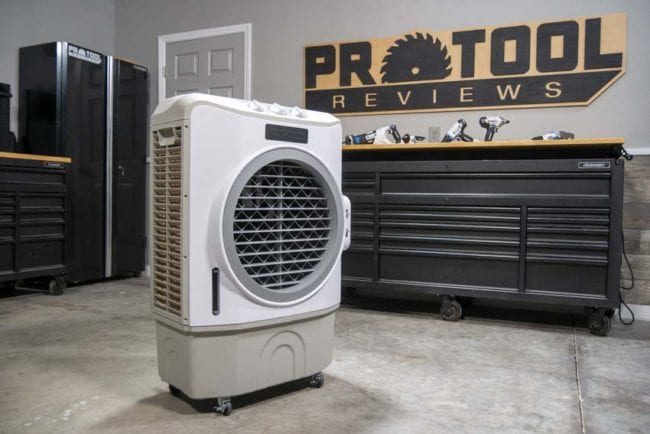
CFM
The Luma Comfort EC220W claims 1650 CFM of airflow. We measured its discharge area at 230.21 square inches (1.60 square feet). Averaging 1197 feet per minute (13.60 MPH), we calculated the actual airflow at 1914 CFM on high. It’s fairly unusual to see a manufacturer’s CFM claims come out lower than what we test, but it’s a nice surprise. Perhaps Luma is just being conservative.
Airspeed Change
Sitting in front of the discharge, the Luma EC220W delivers an average of 1197 fpm. Here’s how it changes over distance:
- 0 feet: 1197 fpm (13.60 MPH)
- 3 feet: 844 fpm (9.6 MPH)
- 6 feet: 607 fpm (6.9 MPH)
- 12 feet: 387 fpm (4.4 MPH)
12 feet is pretty much right at the edge of Luma’s reasonable cooling range. It’s several feet less than the previous two models but still covers a nice area.
Noise Level at 3 Feet (A-weighted, slow response)
- Low: 78 decibels
- Medium: 80 decibels
- High: 81 decibels
Luma’s noise level drops along with its somewhat lower airflow. If you’ve been put off by the noise level of other units, this one has a nice balance of loudness and airflow.
Current Draw
- Low: 1.0 amps
- Medium: 1.1 amps
- High: 1.3 amps
While not quite as energy-efficient as the Honeywell model we tested, the Luma EC220W requires less energy than the larger Hessaire unit to run on medium and high.
GFCI
Luma does not include a GFCI plug on this unit, though it seems to be targeting indoor/outdoor use. We recommend you either use a GFCI extension cord or plug it into a GFCI outlet to reduce the risk of shock if using it outside.
Tank Size
Luma’s 10.6-gallon tank size is generous for the size of the unit and the area it’s designed to cool.
Filter Size
This Luma evaporative cooler has 688 square inches of filter space. It’s an effective filter area to airflow ratio that’s closer to what Hessaire’s larger unit uses.
Additional Notes
- 5 metal blades used for the fan
- Tank fills at the base or with a garden hose (hose end needs to be cut off to use the included hose clamp—bit of a hassle)
- Casters are on the smaller side but roll and turn well
- Manual vertical louver adjustments and automatic lateral oscillation included
More Numbers to Know
- Model: Luma CO610PM
- Manufacturer Recommended Coverage Area: 650 square feet
- Weight: 42 pounds
- Dimensions (H/W/D): 41.13 x 27.00 x 17.00 inches
- Price: $369
Hessaire MC18M Swamp Cooler
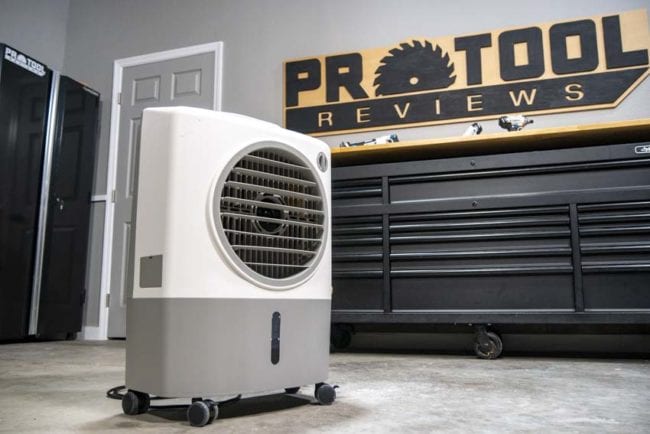
CFM
Representing the compact side of evaporative coolers, the Hessaire MC18M claims 1300 CFM. We measured its discharge area at 115.41 square inches (0.80 square feet). With an average airspeed of 1009 feet per minute (11.47 MPH), we calculated the actual airflow at 808 CFM on high. Like its big brother, it misses its claimed value by quite a bit – nearly 500 CFM or 38% in this case.
Airspeed Change
Standing right at the discharge, the Hessaire MC18M pushes an average of 1009 fpm. Here’s how it changes over distance:
- 0 feet: 1009 fpm (11.47 MPH)
- 3 feet: 783 fpm (8.9 MPH)
- 6 feet: 493 fpm (5.6 MPH)
- 12 feet: 308 fpm (3.5 MPH)
As a compact unit, it’s no surprise that the range is more limited than larger units. This Hessaire swamp cooler does its best work inside 10 feet.
Noise Level at 3 Feet (A-weighted, slow response)
- Low: 67 decibels
- High: 77 decibels
When having a conversation is a high priority, this model gives you much less background noise to contend with.
Current Draw
- Low: 0.3 amps
- High: 0.4 amps
If you’re energy-conscience by choice or by chance, this Hessaire unit draws much less energy than any of the larger models. Requiring just 0.4 amps on high, even portable solar units have a shot at keeping up with the power needed to run it.
GFCI
As with the model above. Hessaire does not include a GFCI plug on this unit, but they also don’t advertise it as an outdoor product. We recommend you plug it into a GFCI outlet to reduce the risk of shock if using it outdoors.
Tank Size
Even though the footprint is much smaller, Hessaire’s 4.8-gallon tank doesn’t seem undersized for the unit.
Filter Size
With 278 square inches of filter space covering the back of the unit (there are no side filters), there’s less filter for the amount of airflow than other units. It’s not going to be as effective at humidity conversion as those with a better ratio.
Additional Notes
- 3 plastic blades used for the fan
- Tank fills at the base or with a garden hose connection
- Fill door opens wide enough to hand feed ice into the tank
- Seams along the plastic are sharper and rougher than other models
- Good casters that roll and turn well for this size unit
- Manual vertical louver adjustments included, but no lateral adjustments
More Numbers to Know
- Model: Hessaire MC18M
- Manufacturer Recommended Coverage Area: 500 square feet
- Weight: 16 pounds
- Dimensions (H/W/D): 28.75 x 19.75 x 10.75 inches
- Price: $209
Check out our other buying guides and head-to-head reviews here!

